 |
|


All electronic donations will be
processed by PayPal
 
 Nantucket/LV-112 Proudly made in USA
Attention
lighthouse lovers!
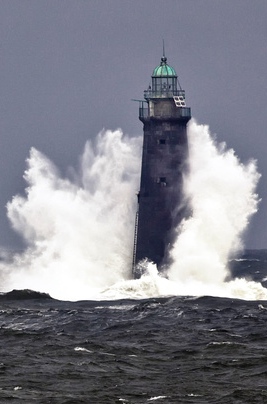
If you love lighthouses and want to learn about these guiding lights and navigational aids all over the world, then
The Lighthouse Directory is the website for you. It provides an astounding amount of information, linking to more than 17,200 of the world's lighthouses. Russ Rowlett, Adjunct Professor of Mathematics at the University of North Carolina at Chapel Hill, compiled the directory with the assistance of hundreds of lighthouse fans around the world who have enriched this site with their own information and suggestions. For a long time, Rowlett tried to maintain a list of lighthouses from his many friends and contacts, but it had grown too long (and too out of date) to display on the comprehensive site. Rowlett offers special thanks to
Michel Forand for his suggestions and editing, touching essentially every page of the directory, and Jeremy D'Entremont, Ted Sarah and Klaus Huelse, each contributing in vital ways.
The Maine
Lighthouse Museum
Another unique educational resource for U.S. Lighthouse history, Lifesaving and Lightship Services is the Maine Lighthouse Museum (MLM), located in Rockland, Maine, the heart of the Midcoast. Last October, the U.S. Lightship Museum presented a PowerPoint presentation at the MLM about U.S. lightships and
Nantucket/LV-112.
The mission of the Maine Lighthouse Museum is to educate the public regarding the longstanding traditions, heroism and progress of America's Lighthouse and Lifesaving Services and the U.S. Coast Guard through the conservation and interpretation of the nation's most significant collection of lighthouse and lifesaving artifacts. From sparkling lenses to heartwarming stories of the keepers and their families, the Maine Lighthouse Museum is truly America's lighthouse museum. For more information, log on to the
Maine Lighthouse Museum or call 207.594.3301.
American Express
Amex Industrial Services, Inc.
Association of Public Safety Communications Officials - Atlantic Chapter
BAE Systems
Bluefin Robotics
Boston Forge & Welding Corp.
Boston Harbor
Shipyard & Marina
The Boston Foundation
ThreeBees Fund
Burnham Associates, Inc.
Burnham Marine
California Public Safety Radio Association
Cameron International Corporation
Charitable Adult Rides and Services, Inc. C/J Towing & Recovery Claflin & Son Nautical Antiques Crandall Dry Dock Engineers
Capt. Robertson P. Dinsmore Fund
Donahue, Tucker & Ciandella, PLLC
East Boston Foundation
Eastern Bank Charitable
Foundation
Egan Maritime Institute,
Nantucket Shipwreck &
Lifesaving Museum
Fitzgerald Shipyard
Foss Maritime
Friends of the
Boston Harbor Islands
H&H Propeller, Inc.
J. Hewitt Marine
Electrical Services
Kelly Automotive Group
H.F. Lenfest Fund
The Lightship Group, LLC
McAllister Towing &
Transportation Co.
Joe and Pepette Mongrain
Fund
National Trust for
Historic Preservation
New England
Lighthouse Lovers
New London Maritime Society and Custom House Maritime Museum The Sail Loft, LLC, Nantucket Sherwin-Williams
Industrial Marine Coatings Division
T & M Services
Town of Oyster Bay,
Long Island, NY
U.S. Coast Guard Lightship Sailors Association
West Marine
U.S. Lighthouse Society
USLM Members
Verizon Foundation
Zuni Maritime Foundation USS Zuni / USCG Tamaroa
Individual Donors


USLM is a member
of the following organizations 
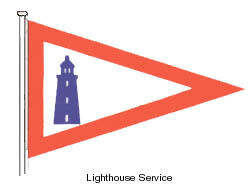
The flag of the United States Lighthouse Service
Teach children about lightships with the book
Lightship
Editorial From School
Library Journal
Kindergarten-Grade 2: Lightships were anchored where lighthouses could not be built. They protected our ocean harbors as well as points along the Great Lakes. The last one (
Nantucket/LV-613
) was decommissioned in 1983, so this fascinating picture book is a piece of nautical history. Brian Floca's watercolor drawings depict daily life aboard one of these vessels, cooking, sleeping, working, all the while rolling with the rhythm of the waves. Many hazards were involved. Big ships came too close, anchors lost their mooring, and weather caused many problems. But when the fog rolled in, the lightship sprang into action. Lights flashed and horns sounded, allowing ship traffic to make it "through fog and night, past rocks and shoals, past reefs and wrecks, past danger." The drawings are very detailed. Some pages are collages of small scenes. Many are full spreads. The sailors' facial expressions are amusing to watch, and the resident cat appears on almost every page. The front and back endpapers show a cutaway view of one of the vessels. This fascinating, little-known slice of history should prove interesting to every child who loves big boats.
-- Ieva Bates, Ann Arbor District Library, MI
(review originally published by Reed Business Information, Inc.)
The book
Lightship
, by Brian Floca, can be purchased on
Amazon.com
. For more information about lightships, click on Brian Floca's
blog
.
 |
|
For more information about the U.S. Coast Guard Lightship Sailors Association and the U.S. Lightship Service, click on logo
|
Lead, Kindly Light
By John Henry Newman
(1801-1890)
"Lead, Kindly Light, amidst th'encircling gloom,
Lead Thou me on!
The night is dark, and I am far from home,
Lead Thou me on!
Keep Thou my feet; I do not ask to see
The distant scene; one step enough for me.
I was not ever thus, nor prayed that Thou
Shouldst lead me on;
I loved to choose and see my path; but now
Lead Thou me on!
I loved the garish day, and, spite of fears,
Pride ruled my will. Remember not past years!
So long Thy power hath blest me, sure it still
Will lead me on.
O'er moor and fen, o'er crag and torrent, till
The night is gone,
And with the morn those angel faces smile,
Which I have loved long since, and lost awhile!
Meantime, along the narrow rugged path,
Thyself hast trod,
Lead, Saviour, lead me home in childlike faith,
Home to my God.
To rest forever after earthly strife
In the calm light of everlasting life."
Note: "Lead Kindly Light" was a poem originally written by John Henry Newman (1801-1890), who was 33 years old when he found himself on a boat from the Sicilian city of Palermo to Marseille, France. Newman, who was recovering after being dangerously ill with a fever, was on the boat to return to his native England when he penned the lyrics to "Lead, Kindly Light." The context that Newman was recovering from a frightening illness in the middle of the sea gives insight to the lyrics.
Photo above: Pigeon Point Lighthouse in California, by Darvin Atkeson
Poem posted on
LV-112 while in service on Nantucket Shoals Lightship Station
"When a sailor gets to thinking
He is one of the best
Let him ship out on a lightship
And take the acid test.
And if he feels like bragging
I don't think that all of his tales
Will be of deep sea sailing
But of the ship that never
Poem provided by Peter Brunk,
USCG-Ret., Commanding Officer,
Nantucket/LV-112, 1970-71, who serves on the USLM Board of Directors
|
This comprehensive New England shipwreck website is a helpful resource for SCUBA divers, maritime history researchers and enthusiasts. The site includes many photographs, charts, reference documents and history about many shipwrecks located in New England waters. For more information,
The Sinking of the U-853
by Capt. William Palmer
When the German enemy submarine
U-853 entered U.S. waters off Portland, Maine in 1945, it torpedoed and sank the
USS Eagle-56.
Nantucket/LV-112, converted to an examination vessel,
USS Nantucket (1942-45) during WWII, helped save the crew of the
USS Eagle-56.
This is a book about the
U-853
story, researched and written by
Capt. Bill Palmer
, a long-time shipwreck researcher, diver and preservationist.
Description of book: "Out in the cold Atlantic Ocean off the coast of Rhode Island, lies the remains of what was once a feared and mighty hunter. It's not a fish or shark, for that matter it is not even a marine creature. It's what men feared the most when they went to sea aboard their vessel back during the World War II years. It's a German submarine called a U-Boat. The
U-853 was the last German submarine sunk in World War II. She was sunk with all hands just minutes before World War II ended. The once mighty hunter feared by all who put to sea, now lies in 130 feet of water off the coast of Block Island, Rhode Island, her grave marked only by a circle on the nautical charts, DANGER Unexploded Depth Charges, May 1945."
Capt. Palmer has been running a charter boat for wreck-diving, shark-fishing and shark-cage-diving off the coast of Rhode Island and Connecticut for 40 years.
German U-boat attack off Portland, Maine, during WWII, involving
LV-112 (USS Nantucket)
This book is the story of a small U.S. sub-chaser, the
Eagle 56, caught in the crosshairs of a German U-boat, the
U-853, whose brazen commander doomed his own crew in a desperate, last-ditch attempt to record final kills before his country's imminent defeat a few weeks later in May. And it is the account of how one man, Paul M. Lawton, embarked on an unrelenting quest for the truth and changed naval history.
For more information, log onto: "
Due to Enemy Action
"
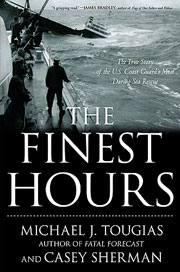
"In February of 1952, one of the worst storms to ever hit the East Coast struck New England, damaging an oil tanker off the coast of Cape Cod and literally ripping it in half. On a small lifeboat faced with frigid temperatures and 70-foot high waves, four members of the U.S. Coast Guard (Bernie Webber and three other crewmen) set out to rescue the more than 30 stranded sailors trapped aboard the rapidly sinking vessel. 'The Finest Hours' is the story of their heroic mission, which is still considered the greatest small boat rescue in Coast Guard history."
(Michelle McCue, 9/9/14)
Bernie Webber (later served on
Nantucket/LV-112, 1958-60) and the three other crewmen were awarded the coveted USCG Gold Lifesaving Medal for their heroism in what is considered by maritime historians to be "the greatest small boat rescue in Coast Guard history." Mr. Webber, who was a member of the USCG Lightship Sailors Association, was extremely helpful in assisting the
USLM-Nantucket/LV-112 compile research information and historic documents about
LV-112. He was a pleasure and honor to work with. Bernie passed away in January 2009. He was considered "A Real American Hero" and is dearly missed.
To learn more about
lighthouse news, click on
Lighthouse Digest
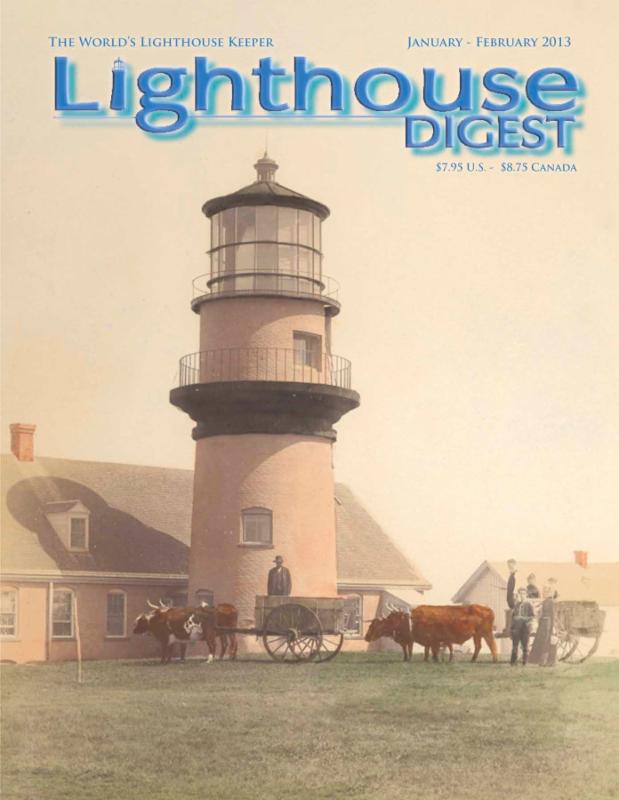
Explore the oceans in depth and Woods Hole Oceanographic Institution with
Oceanus magazine
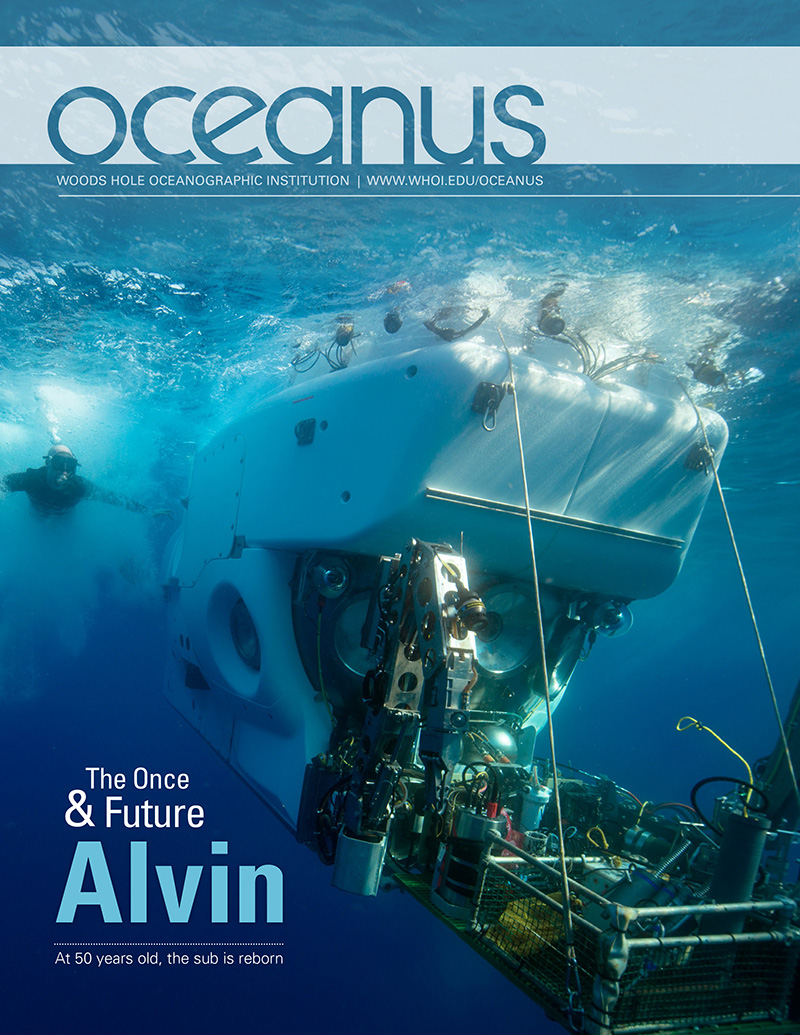
Oceanus
explores the oceans in depth, highlighting the research and researchers at Woods Hole Oceanographic Institution in news, features and interviews written by magazine staff, with full-color photographs and illustrations. Each issue covers a wide spectrum of oceanography, spanning coastal research, marine life, deep-ocean exploration and the ocean's role in climate, as well as ocean technology and policy. To learn more, click on magazine cover above.
Lightships, Lighthouses & Lifeboat Stations:
A Memoir and History
Lightships, Lighthouses & Lifeboat Stations is part history book, part memoir, written by Bernie Webber, recipient of the Coast Guard's highest award, the Gold Life-saving Medal, and hero of the Disney movie The Finest Hours. While the public will recognize Webber's name from the movie and the bestselling book by the same name, few people know that during his lengthy Coast Guard career he served on lightships (ships anchored in dangerous areas to warn other vessels of hazards) in addition to lifeboat stations (small boat rescue stations) and lighthouses. Webber poses the following question: "How did the lightship men cope with the isolation, constant loneliness, boredom, fear, or just sheer terror? All were part of life on board a lightship. Rough seas tossed the ship about, rearing up and down on the anchor chain. This was a world of isolation, noise from operating machinery, and blasts from the powerful foghorn that went on for hours, sometimes days, at a time." Webber answers that question in this book, drawing on a combination of personal experience and meticulous historical research. Discussions of men going mad, lightships being run down by larger ships, anchor chains breaking, and lightships cast upon shoals are offset by humorous stories and the author's reflections on his best days at sea. Fourteen historic photos are included, as well as a foreword by Michael Tougias.(reprinted from Amazon).
Help support the restoration of LV-112 by donating your old car and receive a tax deduction
How it works
We have teamed with Charitable Auto Resources, Inc. (CARS), to accept vehicle donations across the United States. Once
you contact our customer service representative about making a donation, everything will be taken care of, including a receipt for your tax records. Sale proceeds will be donated to the USLM in your name. Donating your vehicle to the U.S. Lightship Museum is as easy as calling our representative toll-free at 855-500-7433.
For more information,
click here
.
The Lightships
of Cape Cod
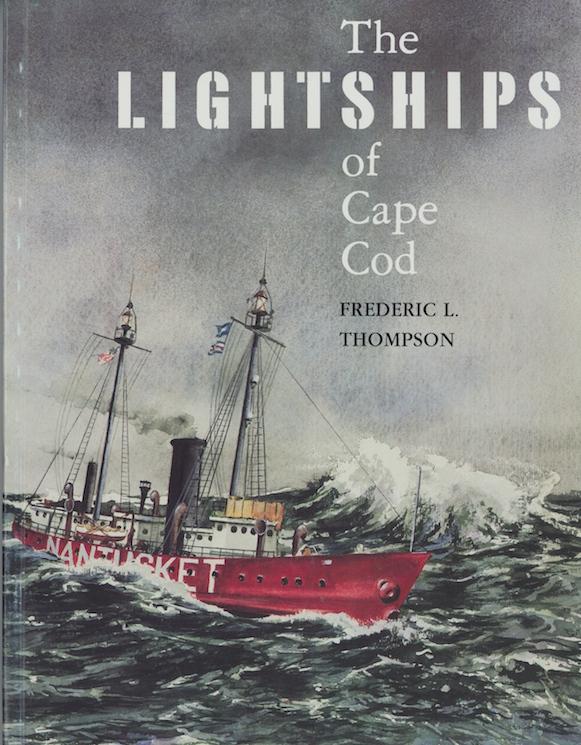
Authored by Frederic L. Thompson, 1996, 2nd printing, 112 pages, soft wrap. Signed by the author. Illustrated with over 93 beautifully detailed photographs. Much sought-after, this scarce volume chronicles the history of the lightships in this vital area. Wonderfully detailed black-and-white photographs enhance the author's vivid description of the history and life aboard these vessels. One of the only volumes ever written exclusively on this subject, this fine work will make a fine addition to any library. Price: $14.95 plus shipping ($5.95), total: $20.90. May be purchased online
from the USLM; just click on "Donate" button in this newsletter and add a notation in the area provided. Or mail a check or money order addressed to: U.S. Lightship Museum, PO Box 454, Amesbury, MA 10913
U.S. Lightship Museums
Relief/WLV-605
|
|
|
A crew member rings the bell on the foredeck of Nantucket New South Shoal No. 1 during low-visibility storm conditions. The i
llustration is from "Life on the South Shoal Lightship" by Gustov Kobbe, Century Magazine, August 1891
Kenrick A. Claflin & Son Nautical Antiques
Click on the website link above to see nautical artifacts available at Kenrick A. Claflin & Son Nautical Antiques, which has donated publications to the USLM.
|
|
|
| |
|
[Note: To see entire eNews, click link above newsletter]
July 4: Celebrate Independence Day festivities on
Nantucket/LV-112
Salute 'Old Ironsides' as she passes by Nantucket Lightship
For more information about how to make reservations for the July 4th
USS Constitution turnaround voyage,
|
Why does the ship say NANTUCKET instead of BOSTON?
The big red lightship, centrally berthed in its homeport of Boston for all to see and visit, triggers the question
|
|
Nantucket Lightship/LV-112 steams past
Boston Lightship/LV-54 en route to Nantucket Shoals Lightship Station from her homeport of Boston Harbor, c. 1939)
|
It seems reasonable to expect Bostonians to prefer the big red lightship berthed in Boston Harbor to broadcast the word "BOSTON," instead of "NANTUCKET." The fact of the matter is that there are no Boston Lightships remaining, except for one. Boston Lightship/LV-118 (built 1938) still exists as a restored lightship museum. So where is it? It is berthed in Lewes, Delaware. However, it does not say "Boston" anymore. Its name was changed to "OVERFALLS." LV-118 served on Boston Lightship Station from 1962-72, in addition to other New England lightship stations.
|
|
| Boston Lightship/LV-118 anchored on station, 1962-72, 6-1/4 miles east-southeast of Boston Light. |
Upon decommissioning by the U.S. Coast Guard, she was donated to the Lewes Historical Society (presently owned by the Overfalls Foundation) and renamed OVERFALLS, because Overfalls Lightship Station was the closest to Lewes. The community of Lewes, in conjunction with the Overfalls Foundation, takes great pride in their lightship museum and beautiful maritime park, built around the historic lightship.
|
|
|
Boston Lightship/WLV-189 weighing anchor for the last time as a commissioned USCG lightship, 1975. The Large Navigational Buoy (LNB) anchored in the foreground, was the new replacement for lightships as they were phased out. LNB's buoy stations were identified with a single alphabet font or acronym (i.e., "B" for Boston, "SF" for San Francisco, etc.). Introduced in 1967, LNBs were moored in open water at approaches to certain major seacoast ports and monitored from shore stations by radio signals. These 40-foot diameter buoys displayed lights from heights of about 36 feet above the water. Emergency lights automatically energized if the main light was extinguished. Some of these buoys may also have had a radio beacon and sound signals. LNBs were eventually phased out and replaced with smaller, more conventional navigational buoys, still maintained by the USCG.
|
Next in line was Boston Lightship/WLV-189, assigned to Boston Lightship Station in 1972 until the station was discontinued in 1975. Upon decommissioning, WLV-189 was transferred to Atlantic City, NJ, to be converted to a lightship/maritime museum. However, Boston/WLV-189 was accidentally hit by another vessel and suffered substantial damage. The cost to repair Boston's last lightship was going to be too expensive for its new owners to fund. As a result, a decision was made to sink the 189 off the New Jersey coast as an artificial reef in 1994. So now, at least the underwater sea creatures and SCUBA divers are enjoying Boston's last lightship.
|
|
|
Boston Lightship/WLV-189, as the retired lightship is scuttled off the coast of Atlantic City, NJ, to serve as an artificial reef. May she rest in peace.
|
Boston Lightship Station (1894-1975) and Nantucket Shoals Lightship Station (1854-1983), were administered by the former U.S. Lighthouse Board and U.S. Light House Service, Second District, and the present USCG, First District, headquartered in Boston. Therefore, that is why the
Nantucket's original and present homeport is Boston. Also,
LV-112 was previously serviced/dry-docked at the Bethlehem Atlantic Works shipyard in East Boston, now Boston Harbor Shipyard & Marina (BHS&M), while a commissioned USCG lightship.
LV-112's present homeport berth is on the East Boston waterfront at the BHS&M.
|
|
|
Nantucket/LV-106 in dry-dock at the Bethlehem Atlantic Works in East Boston, 1928. Photo: Leslie Jones Collection
|
 |
|
 |
Former Boston Lightship/WLV-189 crewmember (1973-74) Bruce Kimball, a native of the Greater Boston area, recently visited
LV-112
and shared his memories of his USCG service on Boston Lightship. During Bruce's four years in the USCG, he also was assigned to other USCG cutters, including the buoy tender,
USCGC Spar WLB-403
. Also, based in Boston during her career, the Spar was a built in 1944, decommissioned in 1997 and sunk as an artificial reef off Morehead, NC, in 2004. She was built as a seagoing buoy tender, served during WWII and had a very distinguished and decorated career in the USCG. These types of vessels also serviced lightships on station
|
There apparently was little interest in operating the former historic "
BOSTON" lightships as maritime museums. Instead, through the efforts of the U.S. Lightship Museum and the support of the BHS&M and East Boston Foundation, Boston Harbor is now graced with "the Queen of all lightships," as stated by Bernie Webber (hero of the "Finest Hours," which recounts the famous 1952
SS Pendleton rescue) in his book, "Lightships Lighthouses & Lifeboat Stations." Also nicknamed the "Statue of Liberty of the Sea,"
LV-112 is a National Historic Landmark and designated National Treasure by the National Trust for Historic Preservation. During her 39-year career, the only years that
LV-112 did not serve on Nantucket Shoals Station were 1942-45 (WWII examination vessel:
USS Nantucket). Actually,
Nantucket/LV-112 did temporarily serve on Boston Lightship Station, among other New England lightship stations, as a
RELIEF lightship (1958-60).
|
|
|
WLV-189's original ship's bell recovered from the decommissioned lightship
|
The only remnant of which we are aware in Greater Boston from a former Boston Lightship, is the ship's bell from WLV-189, which is owned by U.S. Lightship Museum board member, Ron Janard, who purchased it on eBay. Ron is willing to loan the bell to be included in a public maritime history exhibit in Boston, now in the planning stages.
|
LV-112
visitors:
After 64 years, former LV-112 USCG crewmember Dick Arnold is back on board, sharing his epic battle with Hurricanes Carol and Edna
|
|
| Richard (Dick) Arnold, USCG, Ret., on LV-112's foredeck, holding one of two signal flare pistols issued to Nantucket/LV-112's crew in 1936. Dick rescued the two U.S. Remington MK III Signal Flare Pistols from being tossed overboard LV-112, after being deemed obsolete in 1954. He later gave the pistols to Dennis Cosmos, who previously served on Boston Lightship (WLV-189) and a Relief Lightship (WLV-613). Dennis in turn, gifted them back to Nantucket/LV-112. |
|
|
|
Remington MK II Signal Flare Pistols used on Nantucket/LV-112 (1936-54) and rescued from Dick Arnold in 1954 from being discarded overboard. Today, the signal flare pistols are valued from $1,100 to $1,600 by collectors. The MK III was manufactured in the USA by the Remington Bridgeport Works (Remington Arms Co.), Bridgeport, CT. This is somewhat a rare signal flare pistol used by the U.S. Navy prior to World War I (1915-18) and adopted by the U.S. Army during World War I.
|
To read the National Trust for Historic Preservation's interview with Richard Arnold, click here.
|
|
|
The "PHYLLIS A" heading out of Gloucester Mass. harbor to fish in the 1960s, the oldest commercial fishing vessel in Gloucester, retired since 2000. Dick Arnold's father, in Kennebunkport, Maine, built the Phyllis A in 1925. The 57-foot wood built trawler is named for Dick's sister, who, at age 4, helped christen the vessel. It was originally built as a side trawler and eventually converted to a gillnetter.
|
Dick served on the Phyllis A with his Dad as a young boy. Upon his retirement from the USCG (1952-72), he skippered the Phyllis A from 1972 until the boat and he both retired in 2000. Dick was the last captain of the Phyllis A, now undergoing an extensive restoration at Gloucester Marine Railways. A nonprofit organization, the Phyllis A Marine Association, was established to manage and raise funds to restore and preserve the historic fishing trawler/gillnetter. Old vessels such as this are a dying breed and an important piece of maritime history that are, unfortunately, disappearing rapidly.
|
|
|
Dick Arnold (left) in LV-112's pilot house holding LV-112's solid bronze wheel after it was ripped off the helm station by a powerful wave that crashed through several sealed portholes. Dick was standing watch at the helm during Hurricane Edna's 110mph winds and 70-foot mountainous seas. He was hit and thrown back against the ship's bulkhead upon impact. Luckily, he escaped serious injuries, but several of his crewmates did not. Fortunately, there were no fatalities. Although, badly damaged, LV-112 rode out the fierce hurricane, was towed back to Boston for repairs and returned under her own power to her remote station, 100 miles off the U.S. East Coast, continuing her duty as a guiding beacon to ships.
|
Dick grew up as a commercial fisherman along with his father and brothers. A portion of his USCG service was aboard the Nantucket Lightship/LV-112, in addition to other vessels. Richard was also lighthouse keeper at Eastern Point Lighthouse, Gloucester Harbor. One of the most horrific events during his Coast Guard duty was surviving and almost losing his life during Hurricane Edna in 1954. He fought monstrous 70-foot seas and fierce 110 mph winds while serving aboard the Nantucket Lightship/LV-112. As he said, "I thought my life was certainly going to end with the rest of my crewmates during that God-awful hurricane. I had never been so scared in my life." The largest U.S. lightship ever built was severely damaged, disabled and came very close to capsizing.
|
The Harborkeepers, East Boston
|
|
|
The Harborkeepers on board Nantucket/LV-112
|
The Harborkeepers
, a nonprofit group of East Boston-area volunteers, provides coastal, marine education and advocacy within the East Boston coastline for responsible stewardship of the environment. The group recently visited LV-112 for a lesson in local maritime history and how our nation's coastal light beacons helped guide oceanic commerce safely to their ports of call. In addition, they also learned how lightships such as Nantucket/LV-112 participated in oceanic/environmental research and served as weather reporting stations.
|
|
| Nantucket/LV-112 has also hosted students from the U.S. Youth Conservation Corps/National Park Service, together with the Harborkeepers. For more information about the Youth Conservation Corps, click here. |
|
July 14: East Boston Marine Science & Maritime Festival
On Saturday, July 14, 11am-2pm, the U.S.Lightship Museum will be participating in the
East Boston Marine Science & Maritime Festival,
organized by the Harborkeepers in East Boston. As part of their mission of fostering coastal community resiliency, they are hosting this event at Constitution Beach Park
in East Boston to celebrate East Boston's rich maritime history, foster environmental stewardship and ocean conservation through educational, interactive hands-on activities. This will be a day to just have fun by the waterfront with art, science exhibits/activities, live music and food!
|
Nantucket/LV-112 hosts memorial service for John Rowse, founder of Community Boat Building
 |
|
 |
John Rowse, founder of Community Boat Building in Boston
|
On June 2, 2018, nearly 200 friends and family members of John Rowse, celebrated his life in a service held at Nantucket Lightship/LV-112, berthed at the Boston Harbor Shipyard & Marina. John passed away on March 29, after a long battle with cancer.
John founded the Boston Building Materials Co-op in 1978 and co-founded the nonprofit Reuse Center in 1993. He went on to start a third organization,
Community Boat Building (CBB)
.
Founded in 2007, CBB's mission is to bring real-world experience and academic
skills together to stimulate an excitement for learning among low-income students in Boston Public Schools through b
oat building and coastal experiences.
|
|
|
A wooden rowing skiff built by students at the Community Boat Building center, Boston Harbor
|
John was trained as an architect and had a passion for sharing his knowledge
with other homeowners, especially those with limited financial resources, so that they could take good care of their homes. In a 1990 Boston Herald article about the Co-op, he stated, "the ultimate goal is not profit, but helping people solve their housing problems." John's contributions to the organization were extensive. He will be dearly missed.
|
Beacon Hill Village group visits Nantucket/LV-112
|
|
|
Members of Beacon Hill Village visit LV-112 for a tour
|
Members of Beacon Hill Village (BHV), a community grassroots membership organization that sponsors social and cultural programs, visited LV-112 for a tour in May. Prior to the tour, Bob Mannino, president of the USLM, gave a PowerPoint presentation about U.S. lightship history to the BHV membership at their Beacon Hill location.
|
|
|
Members of the Beacon Hill Village, taking a snack and beverage break in LV-112's galley, apparently were so inspired by their surroundings, they broke out singing their favorite sea shanties.
|
|
Fond memories of Nantucket/LV-112, '...the Queen of all the lightships'
Excerpts from, "Lightships, Lighthouses & Lifeboat Stations", by Bernie Webber, Hero of the "The Finest Hours" Pendleton rescue
 |
|
 |
Bernard C. Webber is the recipient of the U.S. Coast Guard Gold Life Saving medal and is the hero chronicled in the book and movie titled, "The Finest Hours." He also served on Nantucket Lightship/LV-112, 1958-60
|
In describing his USCG duty on LV-112, he said, "Few of us remain who witnessed this unique vessel in her natural state operating with steam power host to the great ships of the world. I look back fondly when thinking about my experience. For some, it was a 'deadening existence,' but not for me."
In the book This is the Coast Guard (1972), authors H.R. Kaplan and LCDR James F. Hunt USCG state: "Lightships are the most picturesque navigational aids operated by the United States Coast Guard.
"However, if and when Nantucket is replaced by a buoy or other aid, Coast Guardsmen around the world can sleep easier with the knowledge they will never have to serve on what history has proven to be the Coast Guard's most dangerous station."
|
More excerpts from, "Lightships, Lighthouses & Lifeboat Stations", by Bernie Webber, Hero of the "The Finest Hours" Pendleton rescue...
'Salutes fit for the Queen'
|
|
|
Nantucket/LV-112 on Nantucket Shoals Lightship Station (c.1950) Photo credit: Tony Gimbale (USCG Ret.)
|
"For lightship men, a positive recognition of their otherwise deadening existence was when one of the great ships of the world passed by and would give a "salute" to the red-hulled vessel on duty at its station. We assume the practice had been going on since 1854 for all the lightships that operated the Nantucket Station. (Rules concerning salutes: A man-o-war salutes with guns; merchant vessels salute a man-of-war by dipping their national flag and such salute punctiliously returned by the man-of-war dipping its colors.)
"In 1958, the tradition continued for those of us on board Lightship Nantucket, a highlight in our day was when a great ship appeared on the horizon headed our way. Hearts would beat a little faster when we recognized it to be one of the great ocean liners such as the Rotterdam, Bremen, France, Queen Elizabeth or United States, to name a few.
|
|
|
Lightship sailors waving from LV-112's stern to a passing freighter on Nantucket Shoals Lightship Station, 1936
|
"We knew the ships would pass close by and give our lightship a "salute." We would be able to wave at the passengers high above lining the huge ship's rail or perhaps catch a glimpse of a pretty women, maybe hear a few words yelled from high above. All of it provided for a joyous occasion.
"When an ocean liner was close aboard the lightship the air suddenly would be filled with three loud resounding blasts from large air horns located high up on the big ship's funnels, followed by a shrill whistle and the colors (flags) aboard the liner dipping (lowered then raised again).
|
|
|
Bernie Webber (center) on LV-112's stern giving hair cuts on "Hair Cutting Day" to the crew. Photo credit: Bob Gubitosi, 1959
|
"Responding, the men aboard the lightship moved quickly to the flying bridge and to the flagstaff located at the stern. A seaman on the flying bridge would pull down on a lever activating the lightship's steam whistle and be inundated with a shower of water until the piping cleared the condensation. Once clear, the whistle would find its tone and three blasts sounded in reply to the ocean liner. The seaman stationed aft would dip the lightship's colors. There would be a short blast from the ocean liner in acknowledgement, and the lightship would reply with a short blast completing the ritual."
|
|
|
Nantucket/LV-112 on station, as a steam-powered vessel, responding with a salute from her steam whistle to a passing ocean liner, c. 1950. Photo credit: Tony Gimbale
|
|
|
|
The SS Leviathan (built in 1913), one of many majestic ocean liners guided by Nantucket Lightship between the U.S. and Europe. In 1937 the SS Leviathan was finally sold to the British Metal Industries Ltd. On January 26, 1938, Leviathan set out on her 301st and last voyage under the command of Captain John Binks, retired master of RMS Olympic (ship that collided and sank Nantucket/LV-117 in 1934), who had been hired to deliver the historic ship on her last transatlantic voyage to the shipbreakers in Rosyth, Scotland
|
|
|
|
|
A flotilla of Prohibition-era USCG Rum Chasers berthed on the East Boston waterfront, close to where Nantucket/LV-112's berth is today. Also berthed along side of the Rum Chasers is a USCG floating lifesaving station that was anchored off City Point, Boston Harbor, from 1896-1941, to keep watch on recreational and commercial boat traffic. Different floating stations were used within the existence of the lifesaving station such as the one pictured below in 1906. The station was established to oversee the many sailing regattas that took place from area yacht clubs. Photo credit: Leslie Jones Collection, 1933
|
|
|
Become a USLM member today
|
|
|
For a gift of $1,000 or more, donors will receive a limited-edition, fine-art print of the SS United States passing Nantucket/LV-112, signed by marine artist Gerald Levey
|
Discover the value-added membership benefits when you become a member of the U.S. Lightship Museum (USLM). The USLM is a member of the Council of American Maritime Museums (CAMM). All USLM members will be granted reciprocal privileges (free admission) at participating CAMM institutions. For more information about the benefits and the USLM Membership program, click on USLM Membership.
All electronic donations will be processed by PayPal.
We thank everyone for their ongoing
contributions
and support
|
|
| |
| |
|
|